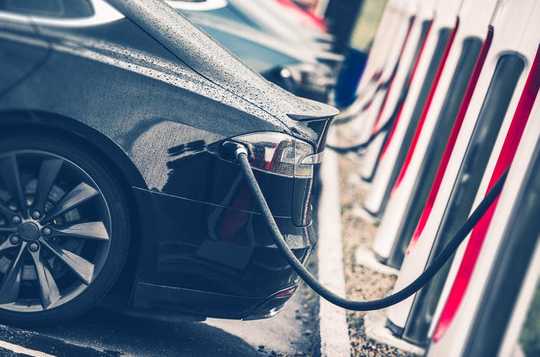 The best way to compare emissions from electric cars is to assess all phases of a life cycle analysis. from www.shutterstock.com, CC BY-ND
The best way to compare emissions from electric cars is to assess all phases of a life cycle analysis. from www.shutterstock.com, CC BY-ND
There is a lot of discussion on the benefits of electric cars versus fossil fuel cars in the context of lithium mining. Please can you tell me which one weighs in better on the environmental impact in terms of global warming and why?
Electric vehicles (EVs) seem very attractive at first sight. But when we look more closely, it becomes clear that they have a substantial carbon footprint and some downsides in terms of the extraction of lithium, cobalt and other metals. And they don’t relieve congestion in crowded cities.
In this response to the question, we touch briefly on the lithium issue, but focus mainly on the carbon footprint of electric cars.
The increasing use of lithium-ion batteries as a major power source in electronic devices, including mobile phones, laptops and electric cars has contributed to a 58% increase in lithium mining in the past decade worldwide. There seems little near-term risk of lithium being mined out, but there is an environmental downside.
The mining process requires extensive amounts of water, which can cause aquifer depletion and adversely affect ecosystems in the Atacama Salt Flat, in Chile, the world’s largest lithium extraction site. But researchers have developed methods to recover lithium from water.
Turning to climate change, it matters whether electric cars emit less carbon than conventional vehicles, and how much less.
Emissions reduction potential of EVs
The best comparison is based on a life cycle analysis which tries to consider all the emissions of carbon dioxide during vehicle manufacturing, use and recycling. Life cycle estimates are never entirely comprehensive, and emission estimates vary by country, as circumstances differ.
In New Zealand, 82% of energy for electricity generation came from renewable sources in 2017. With these high renewable electricity levels for electric car recharging, compared with say Australia or China, EVs are better suited to New Zealand. But this is only one part of the story. One should not assume that, overall, electric cars in New Zealand have a close-to-zero carbon footprint or are wholly sustainable.
A life cycle analysis of emissions considers three phases: the manufacturing phase (also known as cradle-to-gate), the use phase (well-to-wheel) and the recycling phase (grave-to-cradle).
The manufacturing phase
In this phase, the main processes are ore mining, material transformation, manufacturing of vehicle components and vehicle assembly. A recent study of car emissions in China estimates emissions for cars with internal combustion engines in this phase to be about 10.5 tonnes of carbon dioxide (tCO?) per car, compared to emissions for an electric car of about 13 tonnes (including the electric car battery manufacturing).
Emissions from the manufacturing of a lithium-nickel-manganese-cobalt-oxide battery alone were estimated to be 3.2 tonnes. If the vehicle life is assumed to be 150,000 kilometres, emissions from the manufacturing phase of an electric car are higher than for fossil-fuelled cars. But for complete life cycle emissions, the study shows that EV emissions are 18% lower than fossil-fuelled cars.
The use phase
In the use phase, emissions from an electric car are solely due to its upstream emissions, which depend on how much of the electricity comes from fossil or renewable sources. The emissions from a fossil-fuelled car are due to both upstream emissions and tailpipe emissions.
Upstream emissions of EVs essentially depend on the share of zero or low-carbon sources in the country’s electricity generation mix. To understand how the emissions of electric cars vary with a country’s renewable electricity share, consider Australia and New Zealand.
In 2018, Australia’s share of renewables in electricity generation was about 21% (similar to Greece’s at 22%). In contrast, the share of renewables in New Zealand’s electricity generation mix was about 84% (less than France’s at 90%). Using these data and estimates from a 2018 assessment, electric car upstream emissions (for a battery electric vehicle) in Australia can be estimated to be about 170g of CO? per km while upstream emissions in New Zealand are estimated at about 25g of CO? per km on average. This shows that using an electric car in New Zealand is likely to be about seven times better in terms of upstream carbon emissions than in Australia.
The above studies show that emissions during the use phase from a fossil-fuelled compact sedan car were about 251g of CO? per km. Therefore, the use phase emissions from such a car were about 81g of CO? per km higher than those from a grid-recharged EV in Australia, and much worse than the emissions from an electric car in New Zealand.
The recycling phase
The key processes in the recycling phase are vehicle dismantling, vehicle recycling, battery recycling and material recovery. The estimated emissions in this phase, based on a study in China, are about 1.8 tonnes for a fossil-fuelled car and 2.4 tonnes for an electric car (including battery recycling). This difference is mostly due to the emissions from battery recycling which is 0.7 tonnes.
This illustrates that electric cars are responsible for more emissions than their petrol counterparts in the recycling phase. But it’s important to note the recycled vehicle components can be used in the manufacturing of future vehicles, and batteries recycled through direct cathode recycling can be used in subsequent batteries. This could have significant emissions reduction benefits in the future.
So on the basis of recent studies, fossil-fuelled cars generally emit more than electric cars in all phases of a life cycle. The total life cycle emissions from a fossil-fuelled car and an electric car in Australia were 333g of CO? per km and 273g of CO? per km, respectively. That is, using average grid electricity, EVs come out about 18% better in terms of their carbon footprint.
Likewise, electric cars in New Zealand work out a lot better than fossil-fuelled cars in terms of emissions, with life-cycle emissions at about 333 g of CO? per km for fossil-fuelled cars and 128g of CO? per km for electric cars. In New Zealand, EVs perform about 62% better than fossil cars in carbon footprint terms.![]()
About The Author
Md Arif Hasan, PhD candidate, Te Herenga Waka — Victoria University of Wellington and Ralph Brougham Chapman, Associate Professor , Director Environmental Studies, Te Herenga Waka — Victoria University of Wellington
This article is republished from The Conversation under a Creative Commons license. Read the original article.
Related Books
Drawdown: The Most Comprehensive Plan Ever Proposed to Reverse Global Warming
by Paul Hawken and Tom Steyer In the face of widespread fear and apathy, an international coalition of researchers, professionals, and scientists have come together to offer a set of realistic and bold solutions to climate change. One hundred techniques and practices are described here—some are well known; some you may have never heard of. They range from clean energy to educating girls in lower-income countries to land use practices that pull carbon out of the air. The solutions exist, are economically viable, and communities throughout the world are currently enacting them with skill and determination. Available On Amazon
In the face of widespread fear and apathy, an international coalition of researchers, professionals, and scientists have come together to offer a set of realistic and bold solutions to climate change. One hundred techniques and practices are described here—some are well known; some you may have never heard of. They range from clean energy to educating girls in lower-income countries to land use practices that pull carbon out of the air. The solutions exist, are economically viable, and communities throughout the world are currently enacting them with skill and determination. Available On Amazon
Designing Climate Solutions: A Policy Guide for Low-Carbon Energy
by Hal Harvey, Robbie Orvis, Jeffrey Rissman With the effects of climate change already upon us, the need to cut global greenhouse gas emissions is nothing less than urgent. It’s a daunting challenge, but the technologies and strategies to meet it exist today. A small set of energy policies, designed and implemented well, can put us on the path to a low carbon future. Energy systems are large and complex, so energy policy must be focused and cost-effective. One-size-fits-all approaches simply won’t get the job done. Policymakers need a clear, comprehensive resource that outlines the energy policies that will have the biggest impact on our climate future, and describes how to design these policies well. Available On Amazon
With the effects of climate change already upon us, the need to cut global greenhouse gas emissions is nothing less than urgent. It’s a daunting challenge, but the technologies and strategies to meet it exist today. A small set of energy policies, designed and implemented well, can put us on the path to a low carbon future. Energy systems are large and complex, so energy policy must be focused and cost-effective. One-size-fits-all approaches simply won’t get the job done. Policymakers need a clear, comprehensive resource that outlines the energy policies that will have the biggest impact on our climate future, and describes how to design these policies well. Available On Amazon
This Changes Everything: Capitalism vs. The Climate
by Naomi Klein In This Changes Everything Naomi Klein argues that climate change isn’t just another issue to be neatly filed between taxes and health care. It’s an alarm that calls us to fix an economic system that is already failing us in many ways. Klein meticulously builds the case for how massively reducing our greenhouse emissions is our best chance to simultaneously reduce gaping inequalities, re-imagine our broken democracies, and rebuild our gutted local economies. She exposes the ideological desperation of the climate-change deniers, the messianic delusions of the would-be geoengineers, and the tragic defeatism of too many mainstream green initiatives. And she demonstrates precisely why the market has not—and cannot—fix the climate crisis but will instead make things worse, with ever more extreme and ecologically damaging extraction methods, accompanied by rampant disaster capitalism. Available On Amazon
In This Changes Everything Naomi Klein argues that climate change isn’t just another issue to be neatly filed between taxes and health care. It’s an alarm that calls us to fix an economic system that is already failing us in many ways. Klein meticulously builds the case for how massively reducing our greenhouse emissions is our best chance to simultaneously reduce gaping inequalities, re-imagine our broken democracies, and rebuild our gutted local economies. She exposes the ideological desperation of the climate-change deniers, the messianic delusions of the would-be geoengineers, and the tragic defeatism of too many mainstream green initiatives. And she demonstrates precisely why the market has not—and cannot—fix the climate crisis but will instead make things worse, with ever more extreme and ecologically damaging extraction methods, accompanied by rampant disaster capitalism. Available On Amazon
From The Publisher:
Purchases on Amazon go to defray the cost of bringing you InnerSelf.comelf.com, MightyNatural.com, and ClimateImpactNews.com at no cost and without advertisers that track your browsing habits. Even if you click on a link but don't buy these selected products, anything else you buy in that same visit on Amazon pays us a small commission. There is no additional cost to you, so please contribute to the effort. You can also use this link to use to Amazon at any time so you can help support our efforts.




















